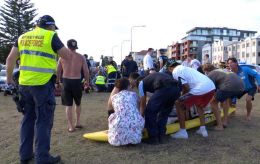Ukraine's on the defensive. Situation on frontlines and signals of new Russian offensive
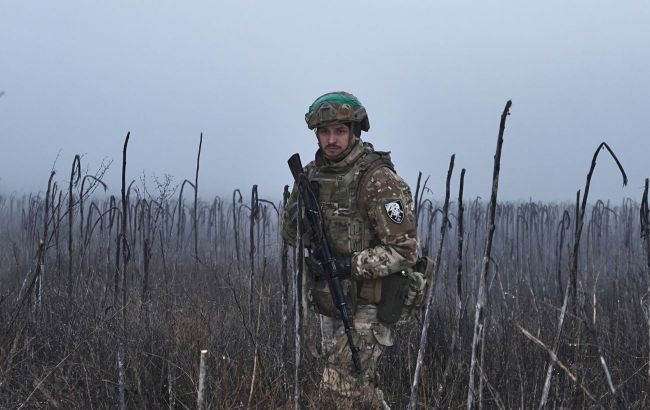 Photo: Ukrainian military restrain Russian army along the entire front (Getty Images)
Photo: Ukrainian military restrain Russian army along the entire front (Getty Images)
Ukrainian forces continue to defend across the entire front. The pace of enemy advancement has decreased, but by the end of spring or the beginning of summer, another campaign may be in preparation.
For more details on the situation on various frontlines and where and when to expect a new Russian Federation offensive, refer to the overview by RBC-Ukraine.
The material was prepared using data from the General Staff, analysis from the Institute for the Study of War (ISW), maps from the DeepState project, statements from military spokespeople, comments from the Chief of the General Staff of the Armed Forces of Ukraine, Oleksandr Syrskyi, and insights from military-political commentator of the Information Resistance group, Oleksandr Kovalenko.
Contents
- Most dangerous fronts
- River defense. What's happening near Avdiivka
- Creeping advance. What's the situation near Chasiv Yar
- Other directions from Kupiansk to Krynky: Brief overview
- Is Russia preparing for a major offensive? When and where it could start
- Terrorist attack at Crocus City Hall. Why Putin needs the story of Ukraine's alleged involvement
Most dangerous fronts
In recent weeks, Ukrainian forces have managed to stabilize the front. President Volodymyr Zelenskyy stated this in an interview with CBS News. According to him, the situation is better than it was two to three months ago when the Defense Forces experienced a shortage of artillery ammunition and various types of weapons. However, even then, Russian occupiers failed to achieve significant success.
Nevertheless, according to the General Staff's reports, there are dozens of combat clashes daily, airstrikes, and artillery shelling. Regarding the most dangerous directions, a military-political observer of the Information Resistance group, Oleksandr Kovalenko, highlights Avdiivka and Chasiv Yar.
"In the area of Avdiivka, these are actions near Berdychiv, Orlivka, Tonenke, and so on. Here they create a security buffer in a semicircle. Then, after an operational pause, they will prepare for offensive actions beyond this buffer. In the area of Chasiv Yar, the situation in Ivanivka should be noted. The occupiers entered the village and occupied positions in the northeast part because it is important for them to create conditions for an advance towards Chasiv Yar itself. These are the most dangerous directions," he said in a comment to RBC-Ukraine.
Furthermore, the situation is complex near Novomykhailivka (the Donetsk region), where the enemy constantly attacks along road 00532 from Mariinka to Vuhledar.
"We also do not forget such locations as Serebrianske forestry, the area of Bilohorivka (the Luhansk region), and the Lyman-Kupiansk axis itself. And, of course, about the Robotyno area of the Zaporizhzhia region. Because the occupiers have still not managed to regain control over it and are trying to continue offensive actions," the expert added.
River defense. What's happening near Avdiivka
The Russian Federation's offensive to the west of Avdiivka has slowed down, encountering the first line of natural obstacles. Several kilometers from the captured city flows the Durna River with cascades of wider ponds, with the Ukrainian Defense Forces positioned on the heights behind them, attempting to hold back the occupiers along the line from Yasnobrodivka to Berdychiv.
Judging from the DeepState project maps, in the second half of March, they took control of the villages of Tonenke and Orlivka, and the defense line shifted to the west. According to the General Staff, in the past day, our defenders repelled 12 attacks in the areas of Berdychiv, Semenivka, Umanske, Pervomaiske, and Nevelske. Here, with the support of aviation, the enemy is trying to dislodge the Ukrainian Armed Forces from their occupied positions.
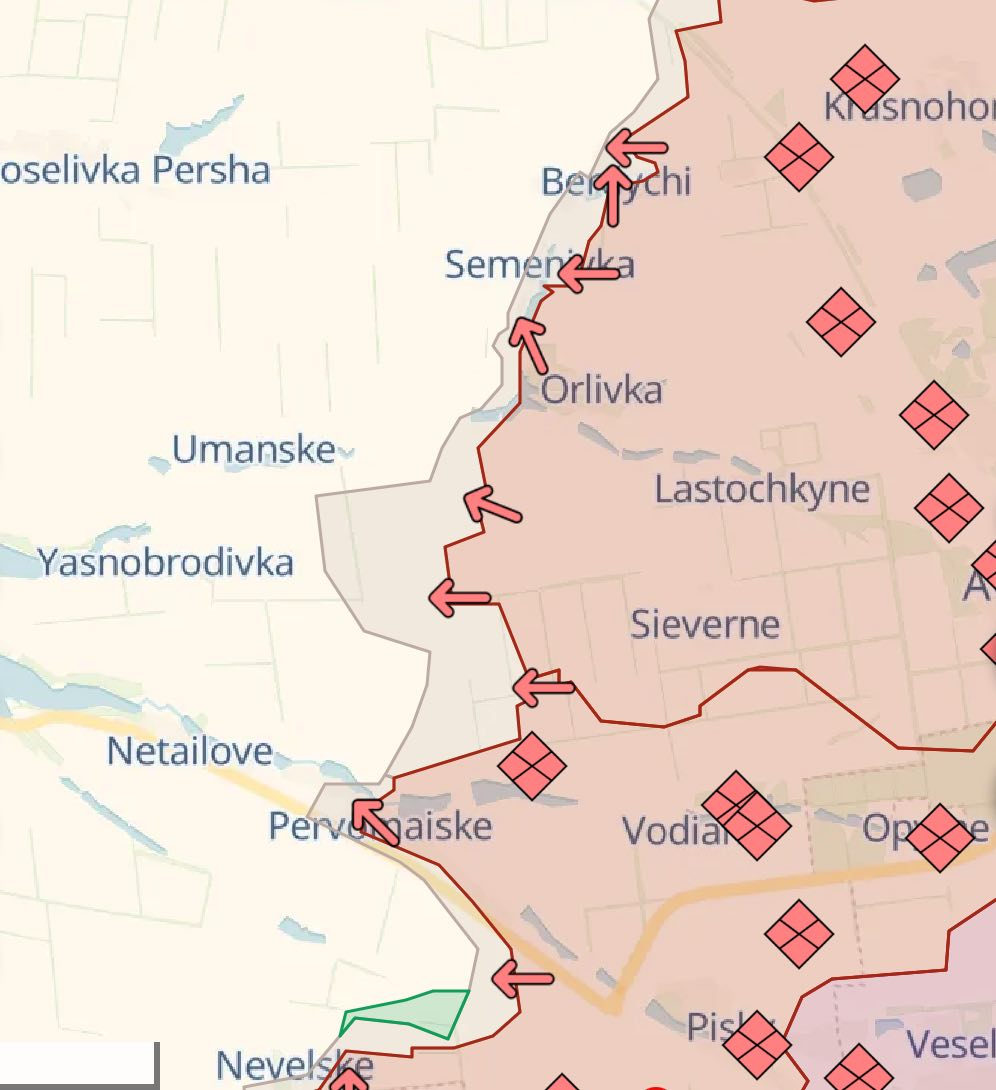
Photo: Russian advance to the west of Avdiivka has slowed down (deepstatemap.live)
According to the commander of the second battalion of the 3rd Separate Assault Brigade of the Armed Forces of Ukraine, Dmytro Kukharchuk, the Avdiivka direction remains the main direction of the enemy's attack, and Russia has deployed a whole army consisting of several divisions here.
"Despite this, the enemy's advancement, starting from Avdiivka and ending these days, has been successfully stabilized," he noted, adding that the progress of the Russian Federation cannot be considered completely halted.
Recently, perhaps one of the largest tank attacks of the entire full-scale war took place here, Forbes reports. In an attempt to advance from Tonenke towards Umanske, 36 tanks and 12 BMPs were immediately involved in the battle. Fighters of the 25th Separate Airborne Sicheslav Brigade destroyed about 20 units of enemy equipment. Almost all of them were captured in a photo taken by a drone.

Photo: A destroyed column of armored vehicles near Tonenke (t.me/Airborne1126)
According to Kovalenko, the column was successfully halted thanks to mined fields and the coordinated work of FPV drones. Due to the shortage of artillery, the Ukrainian Armed Forces have to improvise tactical elements. However, it is better to have all necessary resources and even a surplus to maintain defense.
"Can we say that we will manage without artillery ammunition? No, that's not the case. We need a lot of it because the columns will keep coming again and again," he emphasized.
Creeping advance. What's the situation near Chasiv Yar
On the Bakhmut sector, the Russian army is attacking on a wide front. They are achieving partial success on the northern flank and are getting closer to Chasiv Yar with each passing week. At the moment, the distance from the front line to the eastern outskirts is approximately 1-2 km. If the occupiers manage to capture the village of Ivanivske and advance a few more kilometers, then the main southern logistic route between Chasiv Yar and Kostiantynivka will be under threat.
RBC-Ukraine previously wrote about why this city is important for the occupiers. It is situated on heights from which the Russian forces will be able to take Kostiantynivka and Druzhkivka under fire control, and in perspective, establish a foothold for advancing towards the Sloviansk-Kramatorsk agglomeration. Without the capture of which, achieving one of the goals of the so-called SMO (Special military operation) - the occupation of the Donetsk region - is impossible.
Overall, the defense forces are managing to repel Russian attacks. According to Yurii Fedorenko, a combatant of the Achilles unmanned aerial systems in the 92nd Separate Assault Brigade, the enemy has not succeeded in recent days.
"The direction is heating up. The enemy has concentrated on the Chasiv Yar direction. It's important for them because it's a dominant height," he said.
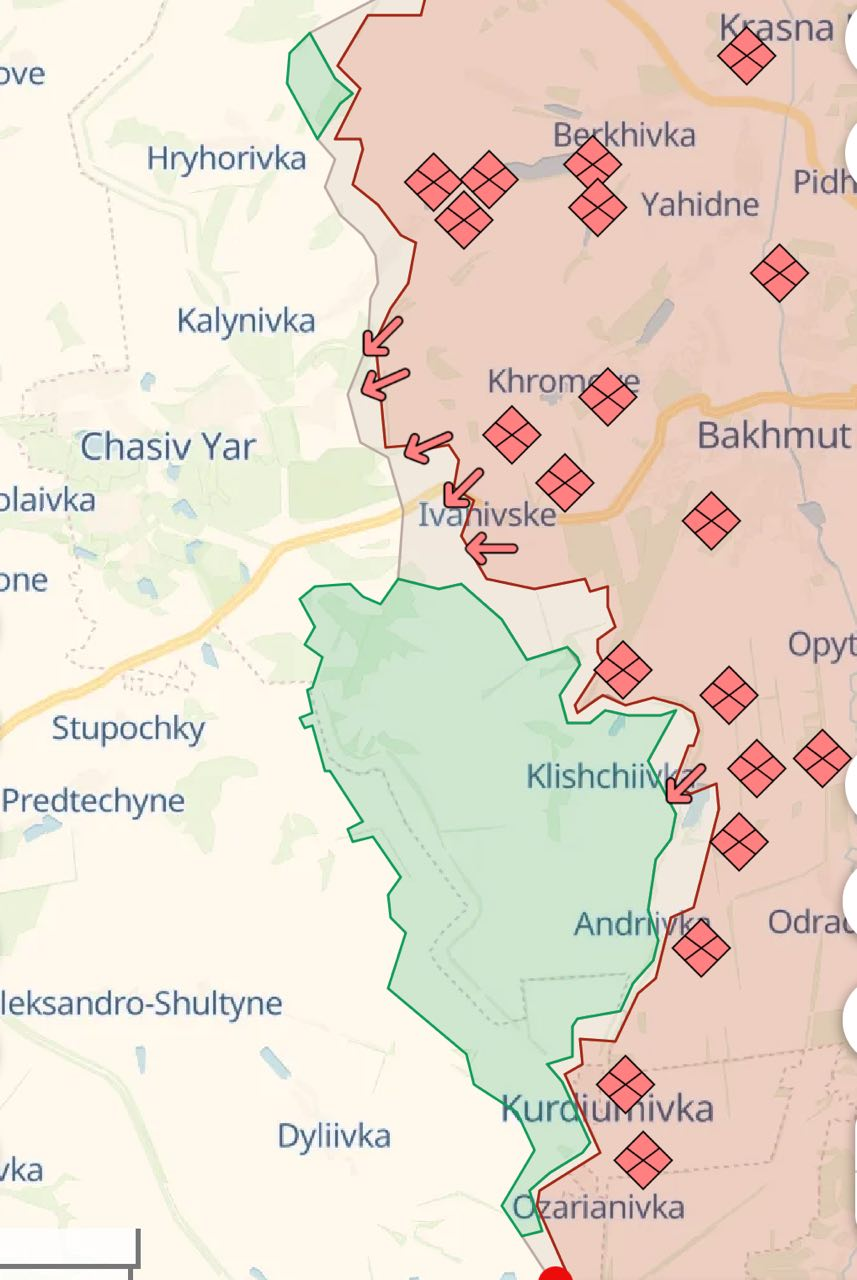
Photo: The enemy is advancing with a fairly wide front from the direction of Bakhmut (deepstatemap.live)
It should be noted that the actual offensive began towards the end of 2023, and in four months, the achievements of the Russian Federation were more than modest. According to analysts at ISW, there are at least two reasons for this. The first is that the Russian army is forced to maintain momentum near Avdiivka, so they couldn't shift forces to Bakhmut. The second is that the Ukrainian forces managed to build "significant fortifications in the form of a ring."
All of this suggests that Chasiv Yar is unlikely to face imminent occupation or encirclement, explains Oleksandr Kovalenko.
"Because there are no conditions for a large-scale advancement. Currently, the enemy has only been able to create conditions for advancing towards villages. They are only capable of acting towards Bohdanivka, Ivanivske, Klishchiivka, and Andriivka. Even at this stage, they face significant problems, but if they capture the villages, they may intensify their offensive actions towards Chasiv Yar in the second half of 2024. The Russians will not give up on it," he emphasized.
Other directions from Kupiansk to Krynky: Brief overview
Near Kupiansk (the Kharkiv region), the enemy attempts to advance near Synkivka and Ivanivka, but without success. Overall, enemy activity here is minimal. For example, according to the General Staff, there were no assaults there in the past day.
As stated by the assistant chief of the Steel Border border detachment, Ivan Shevtsov, the enemy is accumulating personnel and equipment to potentially intensify the offensive towards Kupiansk and Kupiansk-Vuzlovyi. He mentioned that overall, there is an enemy force of around 100,000 troops maintained along the Lyman-Kupiansk axis.
The Russian army is most active in the direction of Lyman (the Donetsk region), particularly near Terny and Bilohorivka, respectively, to the west and south of the occupied Kreminna. It's worth noting that the capture of Lyman would open the way to the Sloviansk-Kramatorsk agglomeration from the north. Currently, the occupiers are attacking Terny, Yampolivka, and Torske, attempting to push the Defense Forces to the opposite bank of the Zherebets River. If successful, the city will be only about 10 km away.

Photo: Occupiers maintain a 100,000-strong force along the Lyman-Kupiansk axis and are actively assaulting the direction of Lyman (deepstatemap.live)
Military observers consider Terny one of the hottest spots. This is partly because the enemy is concentrating forces and increasing artillery strikes. Almost nothing remains of the village itself; nearly all buildings have been destroyed, and Russian propaganda is already anticipating the "liberation" of the next settlement.
To the southwest of the occupied Donetsk, the movement continues near Novomykhailivka towards Vuhledar. Positional battles are ongoing in the areas of Krasnohorivka, Heorhiivka, and Pobeda, while near the administrative border with the Zaporizhzhia region - in the areas of Vodyane, Staryi Mayorsk, and Pryutne.

Photo: The enemy is assaulting Robotyne Heights with almost no armored vehicles (deepstatemap.live)
In the western part of the Zaporizhzhia region, it's hot in the areas of Robotyne and Verbove. Defense forces in the south report that the Russians have intensified aerial reconnaissance and are deploying up to 200 drones per day. As for assaults, armored vehicles are almost not involved in the attacks. This is similar to the situation on the left bank of the Kherson region near our stronghold in Krynky. Here, they conduct from one to three assaults per day with light infantry, also without armored support.
"If on the Zaporizhzhia direction everything is arranged from the landscape to the concentration of troops to regularly conduct assaults, then on the Kherson direction, where the enemy has been unsuccessfully trying to dislodge us from the stronghold in Krynky for many months, they have difficulties in forming assault units," said Natalia Humeniuk, the spokesperson for the Defense Forces of the South of Ukraine, and added that 60-70% of the enemy assault groups do not return from Krynky.
Is Russia preparing for a major offensive? When and where it could start
The military and political leadership of Ukraine speaks of a new major Russian offensive, which could begin at the end of May or the beginning of June. The main questions are whether Russia has enough forces and whether it will focus on one direction.
According to the Russian agency Verstka, Putin's administration hopes to mobilize around 300,000 people, redirecting some to less prioritized areas and freeing experienced soldiers for the advance on Kharkiv. However, such an operation would require extensive maneuvers in open terrain, which were not seen at the beginning of the full-scale invasion.
If the Russian forces do attempt to capture Kharkiv, it will be a fatal city for them, believes the Commander-in-Chief of the Armed Forces of Ukraine, Oleksandr Syrskyi. According to him, the likelihood cannot be ignored, so a complex of measures is already being taken to create defenses. Plans for the use of Defense Forces are also being developed.
He also reminded that Ukraine had a successful experience in 2022 when it managed to anticipate the enemy's actions and liberate a significant part of the Kharkiv region.
"It was then that the large-scale collapse of the Russian front occurred. If the Russians move there again, Kharkiv will be a fatal city for them," emphasized the commander.
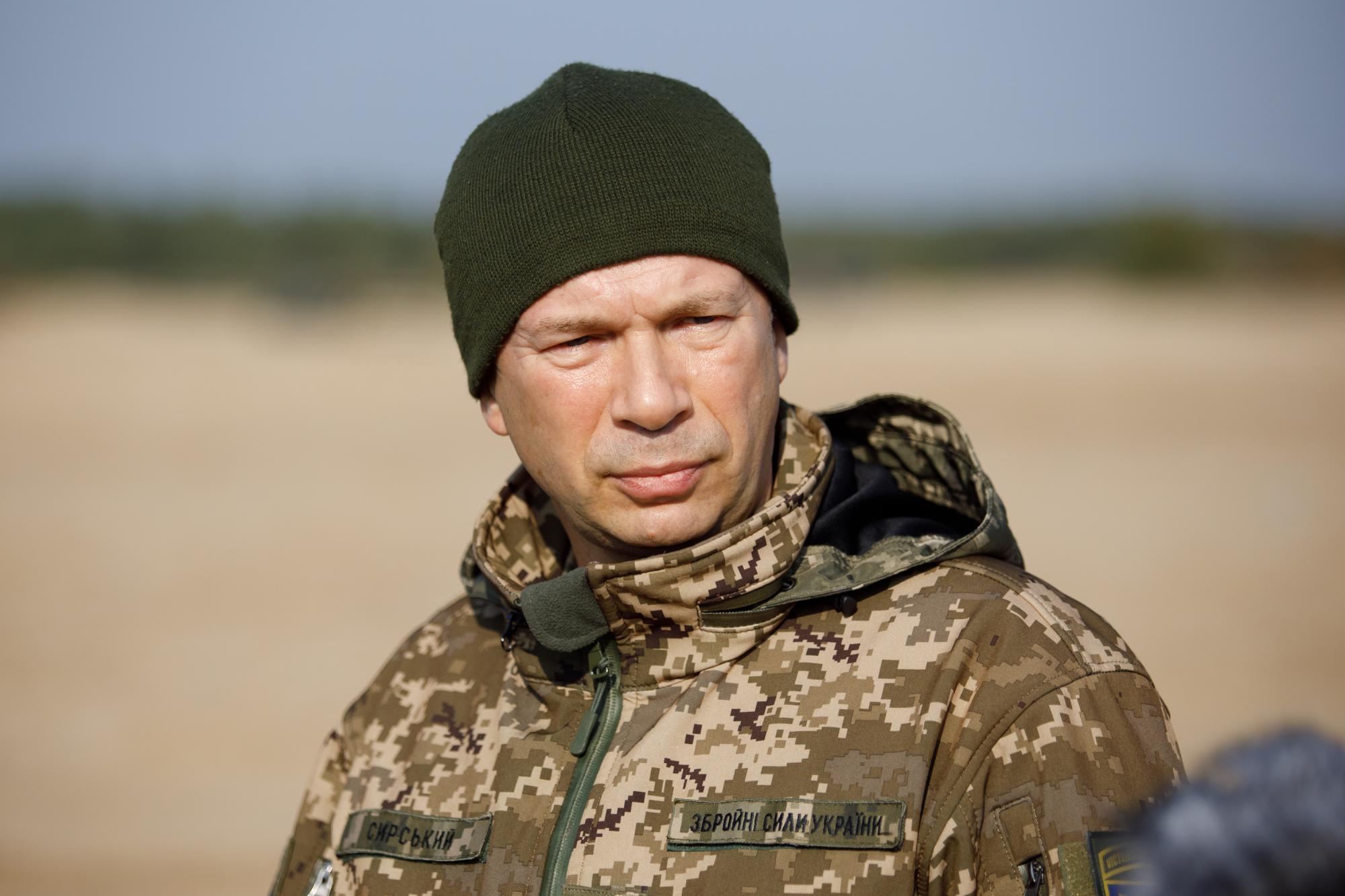
Photo: Commander-in-Chief of the Armed Forces of Ukraine, Oleksandr Syrskyi, is confident that Kharkiv will be a fatal city for Russia if it dares to advance (Vitalii Nosach/RBC-Ukraine).
It should be noted that last week they first attacked Kharkiv with universal inter-service planning ammunition UMPB D-30 (next-generation KABs). And this is alarming considering that according to the usual tactics, the occupiers first bombard cities from the air, after which they advance on the ground.
Expert Oleksandr Kovalenko rules out a Russian offensive on Kharkiv.
"They don't have the resources to go to Kharkiv. As for bomb strikes, this is what they call 'ordinary racism,' terror against the civilian population. The goal is to leave Kharkiv without light, and water, and destroy the infrastructure," he noted.
Analysts of ISW believe that despite the buildup of personnel on the Lyman-Kupiansk axis, near Bahmut, and in other areas, a large-scale operation is only possible in one operational direction. Most likely, the western part of the Donetsk region will come under attack. According to Kovalenko, it is unlikely that Russia will abandon the most priority directions toward Kupiansk and Chasiv Yar. The line from Mariinka to Vuhledar with an exit to the western part of the region ranks only third on the list of priorities where the occupiers will focus in the second half of the year.
The signal for the offensive will be the troops' regrouping, the restoration of combat readiness of units, the accumulation of resources, and the formation of reserves, which is not observed at the moment. Today, there are no conditions for the start of offensive actions, explains the expert.
"We see how they are trying to create several formations on their territory, for example, the 44th Army Corps. However, it is not successful so far, there is a lack of both human resources and equipment. It can be said that the training is, conditionally, at the initial stage, and even then with not the best indicators," he added.
It is worth noting that some officials in the West consider the threat of a major offensive to be exaggerated. The chairman of the Joint Chiefs of Staff of the United States, Charles Brown, doubts Russia's ability to conduct such an operation. He stated that the risk of new escalation from Moscow is "not as high as it might have been at the beginning of the invasion."
Terrorist attack at Crocus City Hall. Why Putin needs the story of Ukraine's alleged involvement
On March 22, 2024, the second deadliest terrorist attack in Russian history occurred. Terrorists attacked people at the Crocus City Hall concert hall near Moscow, engaging in gunfire and setting fire, resulting in at least 144 deaths and over 550 injuries.
The Wilayat Khorasan - an Afghan branch of the terrorist organization Islamic State - claimed responsibility. A total of 12 people were detained, including four suspected perpetrators who turned out to be citizens of Tajikistan. Despite repeated confirmation of ISIS involvement, the Kremlin authorities are pushing the version of the alleged Ukrainian trace.
Russian propaganda and Putin claim that the terrorists allegedly tried to escape to Ukraine. However, this version does not hold up to criticism, as over the two years of war, the border territories have been saturated with troops and law enforcement, noted Ukrainian military intelligence representative Andrii Yusov. President Volodymyr Zelenskyy reacted even more sharply.
"Instead of dealing with his own citizens of Russia, turning to them, this lowlife Putin kept silent for a day - thinking about how to pin this on Ukraine. It's all absolutely predictable," he said.
Later, Alexander Lukashenko dispelled Putin's version. According to him, the terrorists were initially moving towards the border with Belarus. Despite this, last week Putin again linked the terrorist attack to Ukraine, and Zelenskyy in response called him "a sick and cynical creature." Apparently, only Russians believed the dictator. According to OpenMinds polling data, over 50% of the Russian population agree with the Ukrainian trace, and over 75% consider Putin a "reliable source of information."
This Kremlin persistence is aimed at the domestic audience, explains Kovalenko.
"In order to feed Russians the narrative that the so-called Special Military Operation is not in vain. That supposedly they are fighting against a terrorist state and so on. Even Gundyaev (Patriarch of the Russian Orthodox Church Kirill) joined the theme and dispersed narratives about the holy war. So everything is aimed exclusively at the domestic consumer," added the expert.

